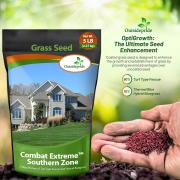Fescue is unique among Southern lawn grasses because it can be grown from seed with relative ease for a relatively low cost. Consequently, if a fescue lawn begins to wane our first impulse is to rush out and buy a bag of seed. However, sometimes you are better off renovating than reseeding.
When a fescue lawn begins to lose color, weaken, and thin, it is easy to blame the weather. The very fact that fescue is a “cool-season grass” forces us to brand heat as the likely culprit. This may be true. But then again, there might be a dozen beautiful fescue lawns in your neighborhood (hopefully not next door) that force you to look beyond the weather for your problem. While intense heat will surely weaken a fescue lawn, it is more often improper mowing, shade, weed competition, or drought that kills fescue grass.
Correcting fundamental problems:
The first thing to remember is that fescue is not meant to grow anywhere and everywhere. In fact, in certain situations, there may be hundreds of more suitable plants for a particular area. The most efficient and inexpensive approach might be to reconfigure or abandon areas that are not suitable for a fescue lawn.
Shade: Tall fescue is tolerant of partial shade. Partial shade is a vague term but usually means 2-3 hours of direct sunlight a day or a thin tree canopy like tall pines. In full shade, a Tall Fescue lawn will become thin and weak. The only answer is to remove a few tree limbs, cut down trees, or reduce the size of your lawn to avoid the shaded area. Raising the mowing height in the shaded areas may alleviate some of the problem but is often impractical. In the middle and upper South, consider sowing Creeping Red or Chewing Fescue in the shadier areas.
Compacted soil: Compacted soil is low in oxygen and will cause Fescue to thin and die. Consider aerating once or twice during the growing season when soil temperatures reach 75-80°. Also, evaluate the cause of the compaction and correct continuing problems by creating walkways for people and pets.
Poor drainage: Fescue lawns will thin and die in wet, soggy soils. These are also some of the most difficult and expensive problems to correct. Before you begin, determine the source of water and where it is trying to flow. Occasionally, you can correct poor drainage by diverting a water source (like a gutter outlet). Other solutions, albeit expensive, include re-grading, French drains, and surface drains. Once soil dries, core aerate to help renovate the root zone.
Improper pH: Fescue prefers a soil pH 6.5. If pH levels stray from this range, your lawn will grow slowly, lose density, and be light green/yellow despite your best maintenance practices. Always consider maintenance problems first, however, before you blame soil pH. If you suspect soil pH, take a soil sample to your local Cooperative Extension Service for testing. They will be able to recommend the needed limed or elemental sulfur to correct the problem.
Steps for Renovating a Fescue Grass Lawn (early September or late February)
- Spray weeds three weeks ahead of time with a post-emergence weed control approved for use on fescue. This will either be early August or early February. Repeat the application a week later for better control.
- Rake. Rake the entire lawn vigorously with a metal-tined leaf rake and remove leaves, dead weeds, grass clippings, rocks, etc.
- Fertilize. Fertilize immediately after aerating with 1 pound of actual nitrogen per 1000 square feet in a quick release form.
- Lime. Apply 50 pounds of pelletized lime per 1000 square feet immediately after aerating.
- Control future weeds. Apply pre-emergence weed control after aerating.






































